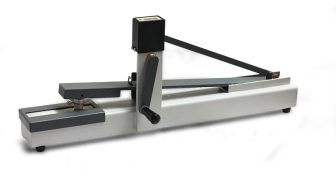
Manual friction color fastness tester
The manual friction color fastness tester is a commonly used model in the textile industry to test the dry and wet friction color fastness of fabrics. Under certain conditions, the sample is rubbed against a standard small white cloth, and the degree of color transfer to the small white cloth is evaluated using a staining gray card. Equipped with a crank arm, counter, stainless steel sample holder, and a testing head with a diameter of 16mm or 25mm (capable of providing a vertical pressure of 9N ± 10%).
Compliant with standards:
BS 1006 D02; ISO 105 D02 X12; AATCC 8 165; GB/T 3920; NEXT TM6 M&S C8 C8A
Applicable scope:
This instrument is suitable for evaluating color fastness friction tests in industries such as textiles, knitwear, leather, electrochemical metal plates, printing, etc.
Accessories and consumables:
1. Friction cloth sample holder
2. Standard friction sandpaper
3. Friction small white cloth (AATCC/ISO standard)
4. Friction Small White Cloth (SDC)
5. Calibrate fabric
6. Grey card (stained) - ISO/BS standard
7. Grey Card (Stained) - AATCC Standard
Measurement steps:
1. Sample preparation:
1.1 The sample and standard friction white cloth shall be conditioned in a constant temperature and humidity environment.
When the sample has multiple colors, all colors should be rubbed against.
1.3 If the area of each color is large enough, samples must be taken separately.
1.4 Cut the sample and perform dry and wet friction separately, ensuring that all colors are rubbed.
If the front and back of the sample are made of different materials and colors, both sides must undergo a color fastness test for friction.
1.6 The dry and wet rubbing fastness should not be repeated on the same part of the sample.
2. Dry friction:
2.1 Place the sample flat on a friction tester covered with sandpaper, ensuring that the length direction of the sample is consistent with the movement direction of the instrument, and fix the sample on the pressure plate. The sample should be clamped flat.
2.2 Fix the standard friction small white cloth on the friction head, clamp it with a spring clamp, and gently place the friction head on the specimen;
2.3 Ensure that the specimen does not slide or wrinkle during friction;
2.4 Place the friction head on the specimen. Turn on the power and turn on the POWER button. Set the number of tests.
2.5 Press the START key to start the test. When the number of tests reaches the set value, the instrument automatically stops.
2.6 Remove the standard friction white cotton cloth and compare it with a color chart for rating.
3. Wet friction:
3.1 Completely immerse the standard friction small white cloth in distilled water;
3.2 After removal, clamp it in filter paper and squeeze it to have a certain moisture content;
3.3 The remaining steps are the same as the dry friction test steps mentioned above;
4. Result processing:
Before rating, use transparent adhesive to gently remove any loose fuzz from the white cloth.
4.2 Use three layers of unused friction white cloth to pad under the friction white cloth to be evaluated, and evaluate the staining level of the friction small white cloth according to the standard staining gray card.
5. Test report:
5.1 Reporting Standard Methods
5.2 Report the results of dry and wet friction separately.